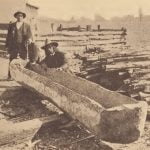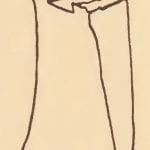The means provided by the Powhatan tribes for transporting themselves about in these marshy wastes was the dugout canoe. No other type of canoe can be ascribed to the southern Virginia culture area, even though Beverley in 1722 figured one of bark as though it were a product of the country. The only explanation of this error is that he credited the Virginia tribes with having what other tribes had, or that a bark canoe had strayed by trade into the tidewater area. The canoe in his sketch is labeled ”birch bark canoe.” This would have been an impossibility for the Virginia tribes, since the canoe-birch does not range on the coast as a native tree much below New England. It was not unusual for early writers to describe Indian life in general terms and to apply the description to special areas. Even the Jesuits occasionally did it. 1
Turning now to the dugout canoe, we encounter an interesting field. Their manufacture and use have ended only with the last generation; so we have first-hand knowledge of details of make and use. Several hulks of abandoned and rotting dugouts are still known lying in the preserving mud in the spots where they foundered. Within recent years Terrill Bradby has made one, and within the last few years Paul Miles has hewn out the large one illustrated in fig. 77. As many as six or seven dugouts belonging to fishermen, drawn up on the shore at the river landing, are remembered by elderly men. The Pamunkey and Mattaponi dugouts were generally made of yellow pine (Pinus taeda), while at Chickahominy, where cypress abounds, they were made of that tree.
Captain John Smith gives an account of canoe-making:
Their fishing is much in Boats. These they make of one tree by bowing [burning] and scratching away the coles with stone and shells till they have made it in forme of a Trough. Some of them are an elne deep, and 40 or 50 foot in length, and some will beare 40 men, but the most ordinary are smaller, and will beare 10, 20, or 30 according to their bignes. Instead of oars, they use paddles and sticks, with which they will row faster then our Barges. 2
At one time Powhatan exhibited to Captain Smith his great canoes capable of carrying forty men, in which they traversed Chesapeake Bay to reach the territories of the Accomac on the Eastern Shore.
Some native made dugouts are still operated by travelers in the ditches of the Dismal swamp, in the old territory of the Nansamond. The form and cut of these boats are identical with those of the Chickahominy craft and with the later types at Pamunkey and Mattaponi, having the pointed ends (fig. 78) . They are undoubtedly of aboriginal model. On these various specimens in eastern Virginia we base our information.
As in other portions of the log-canoe area the Virginia Algonquians burned out the interior of a trunk of a tree and tested the thickness of the walls, as the charring and adzing progressed, by boring holes from the outside in to the depth of thickness desired. Then when the interior was hewn down until the holes were reached, it was known to be far enough. The holes were later plugged up to be water-tight. After the coming of Europeans the Pamunkey acquired iron adzes for hewing. One of these, found broken in the ground near an old house site on the reservation, is shown in fig. 79.
The bottom of the dugout is nearly fiat; the interior has a flat bottom and vertical sides, and the ends project a little over the water-line. An interesting natural angle measure was employed to furnish a pattern for the ends. This was a forked branch, having the right curve and flare (fig. 80).
Laid on the ends of the unfinished dugout the pointing of the bow and stern was marked off from this pattern. The canoes of the older type are remembered as ”tray-heads,” named, it is said, from their resemblance to the native bread-tray or bowl (fig. 92). They correspond to the outline o’ the dugout figured so long ago by Hariot in the Hatteras region. In later times the bow was made sharper, more cut under and scooped. We have a specimen of the old type of canoe made in recent times by Paul Miles, one of the hunters. Its dimensions are : Length, 18 ft.; width at waist, 28 in.; thickness at bottom, 23½ in.; sides above water-line, 13 in.; capacity, five persons; weight about 460 lbs.; “tray-head” bow and short-cut stern. Compared with this specimen several of the cypress dugouts (fig. 78) from the Dismal swamp give the following figures:
- Length, 17½ ft.; width, 2 ft. 8 in.; width of flattened bottom, 18 in.
- Length, 17 ft.; width, 2 ft. 8 in.; width of flattened bottom, 18 in.
- Length, 15½ ft.; width, 2 ft. 2 in.; width of flattened bottom, 13½ in.
The Pamunkey paddled their canoes sitting on boards merely laid across the gunwales. The seats were necessarily movable; it is said, in order to allow the fisherman to move easily about and to shift his position without delay. The Pamunkey, w h o now make and use only the plank canoe, still use the movable seat and continue, as we shall now see, to work with the same type of paddle as that which was formerly used w4th the dug-out. The paddle is a matter of interest and importance to the Indian, for upon it depends his success and even his life, in the severe winds and rough waters of the fishing season. The paddles are long, from five to seven feet. They are generally of red oak, ash, chestnut, or white oak, at Pamunkey and Mattaponi, of white oak, ash, or cypress at Chickahominy. The steering paddle is generally of the same length as the bow paddle, though some fishermen carry five-foot paddles in their canoes, with which the boys paddle when they accompany them.
By the ”shouldered” paddle I refer to the type illustrated in fig. 82, in which the blade widens into shoulders. The grip is always plain. The Pamunkey paddle generally has a stouter staff than the kind used at Chickahominy. The reason for this, given by the Pamunkey, is that their river is rougher and windier than the Chickahominy River, requiring a stouter paddle; by the Chickahominy the reason is given that the latter work more deliberately and quietly in stalking game. They say that the ”shouldered” paddle is noisier than the tapering form while it is in the water. When approaching or stalking game, the paddle is not lifted from the water, but the blade is noiselessly turned sideways at each stroke. The paddles are all very strong and pliable, admirably suited both for poling and for shoving in water or in ooze. They are, however, seemingly heavy, at least two hands accustomed to the light maple paddles of the northern Indians. We must nevertheless admit their superiority under the conditions involved. The Virginia canoe men take a long deep stroke, reaching quite far forward to “dig in and grip” the water. The lower hand rests on the leg to give more leverage power. It requires great strength to move and steer the heavy water-logged dugouts and plank boats now used. The canoe man never kneels, but sits on the loose board seat, with knees bent, or with one leg extended straight out.
The bailer is a scoop made of one piece of wood with a projection forming the handle.
Some rather interesting folklore is associated with the dugout. The slime which coats the pebble or mud beaches of the tide water rivers permits the canoe, no matter how heavy, to be slid to the water’s edge and launched again by two men when needed at low tide. According to tradition at Pamunkey, it is believed that in shoving out from the shore the canoe should be first turned ”sun wise,” or with the sun, that is, from east to west. After this formal direction in leaving the shore has been taken, the canoe may be turned in the direction desired.
Like the northern Algonquians, the Pamunkey canoe men appraise one another of game observed by a sudden jerk of the body, which, communicated to the canoe, startles the other occupant of the boat to a sense of alertness. The Pamunkey call this warning a ”shiver.” One “shiver” is a signal to be quiet and paddle gently, for a noise or a glimpse of something has been sensed. Two “shivers” mean, “Do you see it?” A “shiver” from the other hunter is an affirmative.
Powhatan Canoe Gallery
Citations:
- This declaration by Speck may be in error. Colonel James Smith, who was captured by and resided with Caughnewaga Indians in the Ohio Valley, helped build birch bark canoes, and he was well south of New England at the time. It is possible that in the 1600’s there were enough birch trees in the highlands of Virginia to have had canoes built. We also know from reading about the capture of Mr. Smith, that the Indians built their canoes from other bark, including elm trees. See: Life and travels of Colonel James Smith – Indian Captivities.[
]
- Smith’s account of Virginia in Tyler, L. G., Narratives of Early Virginia, New York, 1907, p. 103. [
]






